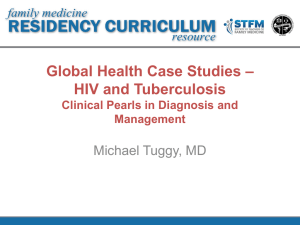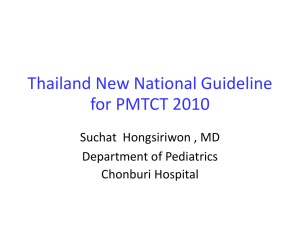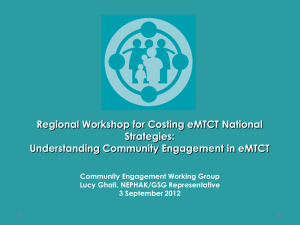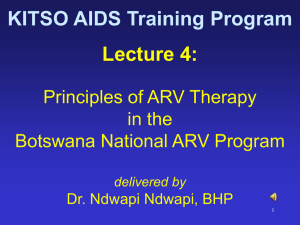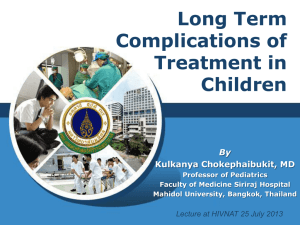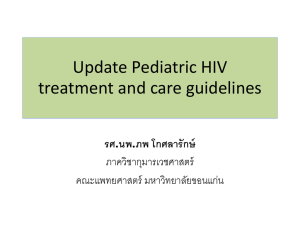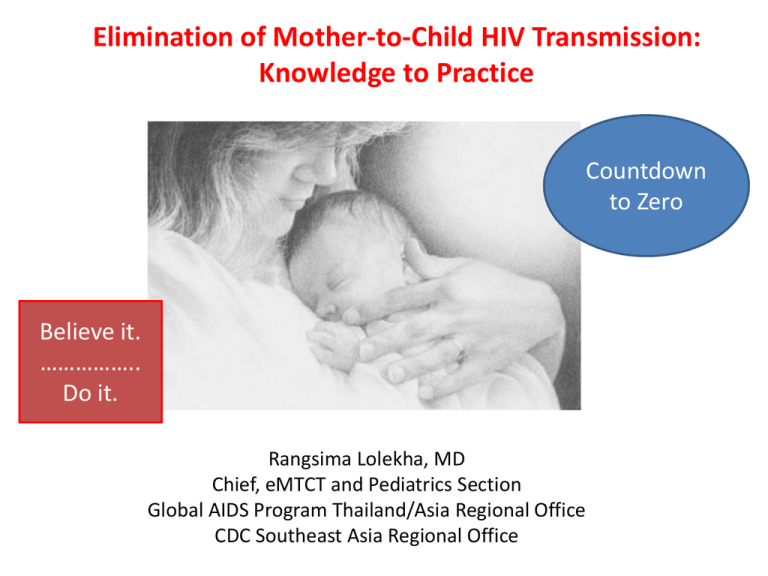
Elimination of Mother-to-Child HIV Transmission:
Knowledge to Practice
Countdown
to Zero
Believe it.
……………..
Do it.
Rangsima Lolekha, MD
Chief, eMTCT and Pediatrics Section
Global AIDS Program Thailand/Asia Regional Office
CDC Southeast Asia Regional Office
Outlines
• Global goals to elimination of MTCT and AIDS
Free Generation
• Key summary of PMTCT interventions and
new Thai PMTCT guidelines 2014
• Situation of MTCT rate and early infant access
to treatment and care in Thailand
• UNAIDS recommendations for Country
Implementation Action: 10-Point Plan towards
eMTCT
Global Goal: Towards EMTCT by 2015
• Global Target #1: Reduce the number of new
HIV infections among children by 90%
• Global Target #2: Reduce the number of AIDS-
related maternal deaths by 50%
Launched by UNAIDS and PEPFAR: calls for exceptional
global and national efforts
Reduce MTCT of HIV to
<5% in breast-fed population
<2% in non-breastfed population
Millennium Development Goals and EMTCT
The EMTCT contributes directly towards achieving four of the
MDGs
MDG3: Promote gender equality and empower women
MDG4: Reduce child mortality
MDG5: Improve maternal health
MDG6: Combat HIV/AIDS, malaria and other diseases
Key elements of prevention of HIV transmission to
babies and keeping their mothers alive
The Virtual Elimination of MTCT of HIV is Possible
Estimated New HIV infections among children 0-14:
Different scenarios for 25 countries with largest numbers of HIV+ pregnant women
Source: Mahy M, Stover J, Kiragu K, et al. What will it take to achieve virtual elimination of mother-to-child
transmission of HIV? An assessment of current progress and future needs. Sex Trans Infect (Suppl) 2010.
Monitoring Framework for 2015
Estimated Risk and Timing of
Mother-To-Child (MTCT) HIV Transmission
In utero
0-14 wk
1%
Post partum through
breastfeeding
Delivery
14-36 wk
4%
36 wk labor
During
labor
12%
0-6 month
7%
8%
6-24 month
3%
Overall without breastfeeding
20-25 %
Overall with breastfeeding till 6 months
25-30 %
Overall with breast feeding till 18-24 months
30-35 %
Source: De Cock KM, et al. JAMA. 2000; 283 (9): 1175-82
Kourtis et al. JAMA 2001; DeCock et al. JAMA 2000
The risk of perinatal transmission can now be less than 2% (1 in 50) with:
Highly effective ARV therapy (HAART), elective cesarean section as appropriate;
formula feeding
PMTCT is the most effective intervention among
prevention technologies reducing HIV transmission
cART vs. no ARV (076 placebo) (0.8% vs. 25.5%) US/Europe 2006
97%
Option A vs. no ARV S Africa (1.5% vs. 22%) Dihn 2011, IAS; Rundare 2012, CROI
93%
Karim SSA et al. Lancet 2011;378:e23-25
Adapted from Mofenson L’s slide
Summary of peripartum transmission probabilities by ART regimen
and maternal CD4 count
(The UNAIDS reference group on estimates, modelling and projections)
Incident peripartum infections with no ARV prophylaxis
(range of reported transmission probabilities) = 30% (13-30%)
40%
37%
35%
30%
25%
20%
15%
The risk of perinatal transmission can now be less
than 2% with HAART and formula feeding
27%
22%
15%
12%
10%
4%
5%
2%
2%
2%
0.5%
0%
No prophylaxis
sd NVP
CD4 not specific
Option A
CD4<200
Option B
CD4 200-350
HAART
HAART (before
pregnancy)
CD4 >350
Rollins N et al. STI 2012
Postnatal Transmission rate per month of any breastfeeding
probabilities by ART and maternal CD4 count
(The UNAIDS reference group on estimates, modelling and projections)
Incident postnatal infections with no ARV prophylaxis
(range of reported transmission probabilities) = 28% (14-56%)
1.8%
1.6%
1.57%
The risk of perinatal transmission can now be less
than 5% with HAART and exclusive BF for 12 mo
1.4%
1.2%
1.0%
0.8%
0.6%
0.51%
0.4%
0.20%
0.2%
0.16%
0.0%
No prophylaxis
HAART (IP, PP, postpartum)
CD4<350
HAART before pregnancy
CD4>350
Rollins N et al. STI 2012
The Mississippi Baby: Functional Cure of HIV
Persaud D, 2013 CROI, Abstract 48LB
The Way Forward:
Mimicking the Mississippi baby
Early diagnosis of
infected babies
Nation-wide
active enrollment
Immediate ART to
minimize latently
infected cells
Triple ART
Including to high-risk
Infants immediately
after birth
ART interruption in
clinical trial
Control HIV viremia
Thai GL 2014 สู ตรยาต้ านไวรัสและระยะเวลาในการให้ ยาต้ านไวรัสสาหรับ
หญิงตั้งครรภ์ ทไี่ ม่ เคยได้ รับยาต้ านไวรัสก่ อนเริ่มตั้งครรภ์
สูตรที่แนะนำ
สูตรแรกที่แนะนำ
TDF+3TC+EFV
สูตรทำงเลือก#
TDF หรื อ AZT+3TC+LPV/r
กำรเริ่มยำ
กำรหยุดยำ ให้ พิจำรณำตำมควำมสมัครใจ
(ไม่ต้องรอ
และควำมพร้ อมในกำรกินยำ
ผล CD4
count)
เริ่มยำทันที - ให้ ยำต่อเนื่องหลังคลอด ในทุกรำยที่สมัครใจ มีควำมพร้ อมและ
โดยเร็วที่สดุ สำมำรถกินยำได้ ต่อเนื่อง สม่ำเสมอ โดยเฉพำะกรณีต่อไปนี ้
CD4 count ก่อนเริ่มยำ <500 cells/mm3
กรณีที่มีค่ผู ลเลือดลบ หรื อไม่ทรำบผลเลือดของสำมี
มีกำรติดเชื ้อวัณโรค หรื อ HBV หรื อ HCV ร่วมด้ วย
โดยให้ สง่ ต่อเพื่อรักษำต่อเนื่องกับแผนกอำยุรศำสตร์ และเปลี่ยนสูตร
ยำตำมแนวทำงกำรดูแลรักษำผู้ใหญ่
-ขนาดยา: AZT 200-300 mg q 12 ชม.; 3TC 150 mg q 12 ชม.; AZT + 3TC (300 + 150) q 12 ชม.; LPV/r (200/50) 2 เม็ด q
12 ชม.; EFV 600 mg q 24 ชม.
# ในกรณีที่มีอย่ำงน้ อย 1 ข้ อต่อไปนี ้:
ไม่แน่ใจว่ำหญิงตังครรภ์
้
จะสมัครใจกินยำต่อหลังคลอดหรื อไม่ CD4 >500 cells/mm3
มีประวัตสิ ำมีของหญิงตังครรภ์
้
รับกำรรักษำด้ วยยำต้ ำนไวรัสและสงสัยกำรดื ้อยำ
หญิงตังครรภ์
้
เคยรับยำสูตร AZT+SD NVP มำก่อน
Thai HIV Treatment and Care Guidelines 2014:
PMTCT Recommendations
• Early HIV diagnosis and immediate lopinavir/r-ART in all HIV-infected
infants. The triple-ARV prophylaxis regimen for children at high risk for HIV
similar to that in the Mississippi baby.
*Infants at high risk for HIV infection: those born to mothers with no ANC, <4 weeks of
triple-ART or failing ART (VL>50 copies/mL)
สู ตรยาต้ านไวรัสเพือ่ ป้ องกันการถ่ ายทอดเชื้อเอชไอวีจากแม่ ส่ ู ลูกในไทย
กรณีไม่ ฝากครรภ์ หรือเสี่ ยงสู งต่ อการที่ทารกจะติดเชื้อ 2014
เสี่ ยงสู ง: ART < 4 wk, poor adherence, VL>50 at 36 wk GA/delivery, recent exposure
สถานการณ์
ไม่ได้ฝาก
CD4>500
ครรภ์หรื อเสี่ ยง cells/mm3
สูงต่อทารกติด
เชื้อ
CD4< 500
cells/mm3
ก่อน
คลอด
-
-
ระหว่างคลอด
หลังคลอด
แม่
ให้ยา HAART ต่อเนื่องหลัง
คลอดทุกราย ยกเว้นในราย
AZT (300) ทุก ที่ไม่สมัครใจกินยาต่อหลัง
3 ชัว่ โมง + SD คลอดให้AZT+3TC+LPV/r
NVP*
x 4 สัปดาห์แล้วจึงหยุดยา
ทารก
-AZT+3TC+NVP 6
สัปดาห์ หรื อจนกว่าจะ
ได้ผล PCR เป็ นลบอย่าง
น้อย 1 ครั้ง
•ไม่ตอ้ งให้ SD NVP ในหญิงตั้งครรภ์ที่คาดว่าจะคลอดภายใน 2 ชัว่ โมง
• ถ้าแม่ไม่ได้ SD NVP ไม่จาเป็ นต้องให้ tail: AZT+3TC+LPV/r แต่ให้ HAART ต่อตามแนวทางการ
รักษาในผูใ้ หญ่
Timeline for EID and early HIV treatment and
care for infants born to HIV+ mothers
Standard
risk
AZT
High risk
AZT/3TC/NVP
PCR 1
PCR 2
PCR 1
0
1 mo
PCR+ at 1 mo
PCR+ at 2 mo
PCR+ at 4 mo
HIV antibody
PCR 2
2 mo
PCR 3
HIV antibody
4 mo ……........12-18 mo
age
AZT+3TC+LPV/r
AZT+3TC+LPV/r
AZT+3TC+LPV/r
*ให้ เก็บเลือดทำรกทุกรำยที่คลอดจำกแม่ติดเชื ้อเอชไอวีใส่กระดำษกรองไว้ (dried blood spot) เหมือนตรวจคัดกรองไทรอยด์เมื่อแรก
เกิด และส่งเลือดไปที่กรมวิทยำศำสตร์ ทำงกำรแพทย์พร้ อมกำรส่งตรวจคัดกรองไทรอยด์ ในกรณีที่เด็กติดเชื ้อเอชไอวีจำกผล PCR ที่ 1-2
เดือน หำกมีเลือดเก็บไว้ ที่แรกเกิดทำงกรมวิทยำศำสตร์ ทำงกำรแพทย์จะตรวจ DNA PCR เพิม่ เติมให้ เพื่อวินิจฉัยว่ำเป็ นกำรติดเชื ้อตังแต่
้ ใน
ครรภ์หรื อระหว่ำงคลอด ซึง่ อำจมีผลต่อแผนกำรรักษำในอนำคต
MTCT Rates 2013: 1.7% (accessed to PCR only)
Weighted Average: 2.3%
AIDS Zero portal website
Cascade of ARV-PMTCT/ART among Mothers
NAP-Plus Database, NHSO 2009-2012
(58.3%)
* Under reported
Receipt of ARV (%) by Women Giving Birth with HIV-Seropositive (2013-14)
79% for Rx
2012: N = 2,461 (65% report)
2013: N = 3,193 (79% report)
Source: DOH as of 17/04/2014
Cascade from Early Infant Diagnosis to Antiretroviral Treatment
2008-2011
150
ART before 1 year of age
157
Overall ART
119
111
109
90
100
33
50
241
47
45
32
0
Received CD4 count test
2008
298
2009
2010
2011
Infants with at least one PCR positive
Registered in NAP
Registered in NAP
341
Received CD4 count test
Infants with at least one PCR
positive
429
0
100
200
300
400
Overall ART
4b
ART before 1 year of age
500
14.0
12.0
11.7
11.3
Months
10.0
8.0
8.3
11.2
8.7
8.2
6.0
7.0
6.6
Median age at first
CD4 (months)
4.0
EID program evaluation 2008-2011:
Thai MOPH, CDC Thailand, UNICEFThailand
Median age at ART
(months)
2.0
0.0
2008
2009
2010
2011
4c
HIV Treatment Cascade in the Real World
• In a perfect world, all HIV infected individuals would follow the same
pathway in the spectrum of engagement into care:
HIV
Infected
HIV
Diagnosed
Linked to
HIV Care
Retained
in HIV
Care
Need
ART
On
ART
Adherent/Supp
ressed
• In the real world, there is leakage between each of these steps and
individuals are often lost-to-follow-up.
• Understanding the leakage points and their causes are essential to
optimize the effectiveness of HIV treatment program.
• Comprehensively monitoring in standardized metrics is needed
Country Implementation Action: 10-Point Plan (1)
1. Conduct a strategic assessment of key barriers to eMTCT
2. Develop or revise nationally-owned plans towards eMTCT
3. Assess the available resources for eMTCT and develop a
strategy to address unmet needs
4. Implement and create demand for a comprehensive,
integrated package of HIV prevention and treatment
interventions and services
5. Strengthen synergies and integration fit to context between
HIV prevention and treatment and related health services to
improve maternal and child health outcomes
UNAIDS: Global plan towards the elimination of new HIV infections
among children by 2015 and keeping their mothers alive 2011-15
Country Implementation Action: 10-Point Plan (2)
6. Enhance the supply and utilization of human resources for
health
7. Evaluate and improve access to essential medicines and
diagnostics and strengthen supply chain operations
8. Strengthen community involvement and communication
9. Better coordinated technical support to enhance service
delivery
10. Improve outcomes assessment, data quality, and impact
assessment
UNAIDS: Global plan towards the elimination of new HIV infections
among children by 2015 and keeping their mothers alive 2011-15


